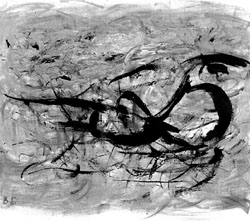Artist Volodymyr Budnykov And His Success

It is incredibly difficult to write about successful artists. All there is to write seems to have been written. After all, they are successful. What more can you say? Also, success is never blamed. Stories about geniuses wasting their lives in mansards have long been recognized for what they are, romantic drivel. An artist working hard and earning big money literally with his own hands makes a far more interesting subject. On the other hand, is it not dangerous to mistake the former for the latter or vice versa? Well, the prejudice proves to cut both ways in the end. Some actually identify fragile brilliance with specific worldly benefits; others feel certain that only persons completely without talent can elbow their way to the top — a gift of nature, perhaps as compensation.
Volodymyr Budnykov ranks with the well-established and truly successful artists. The prestigious title, Meritorious Worker of Art of Ukraine, and even his professorship at the Ukrainian Academy of Arts occupy a relatively insignificant place in the long record of his attainments. He is described as a “researcher in the field of pictorial metaphysics and founder of the non-baroque trend in nonfigurative painting.” A dissertation on his creative heritage was defended in Germany. The list of Budnykov’s works on display at museums and in private collections contains eight lines in fine print. And one could continue in this vein forever.
His one-man show at the L’Art Gallery is called Retrospective. The current exposition is an example of a rare and truly nonprofit initiative. Collecting works of a single artist, one of the most popular and salable Ukrainian painters to date, and displaying them in one place is an extremely difficult task. Collecting such works dating from different periods and building the exhibit so as to convey a coherent message is practically impossible. L’Art did both (there are quite a few items on display, the earliest pictures dating from the 1970s and the latest from the current day).
A message is definitely conveyed, albeit in chronological rather than logical order. The buildup, even with the aid of such all-embracing notions as picturesque quality (“The road chosen by Volodymyr Budnykov leads to mysteries and universal truths almost exclusively pictorial by nature, or rather which leads to the pictorial form. Picturesque quality is the principal distinction of the artist’s image world. His views on the fine arts are quite mobile and changeable, at times controversial, as varying in depth as is the essence of his pictorial art,” art critic Soloviov wrote ten years ago), “obsession with lyrical landscapes” or with the ‘non-baroque’ style are just a convenience. The road from the monumental art studio at Kyiv’s Institute of Art, then under Tetiana Yablonska’s guidance, to the “minimalism of color and hieroglyphic plastic compositions” is not just a long one. Perhaps it would be best to describe it not as a curve (an upward or downward one, or a broken line, however one sees it, which is not that important), but as a rich cluster of beams emanated from a single center. Most likely, this center is pictorial art, from which Volodymyr Budnykov has moved in different directions in different decades, toward primitivism, icon-painting, and non-baroque non-figurativism.
Also, Budnykov’s road in general leads to freedom. He is absolutely free now, due to his undeniable success. He can create whatever he thinks necessary. In other words, at some point on his road, a point which is totally unknown and cannot be assessed in terms of tangible assets, his “I Must” has to become “I Can.” True, the horrible thing is that the notion of duty is an extremely voluminous one; I Must means precisely one’s duty. What about I Can? Does it mean nothing but success?






